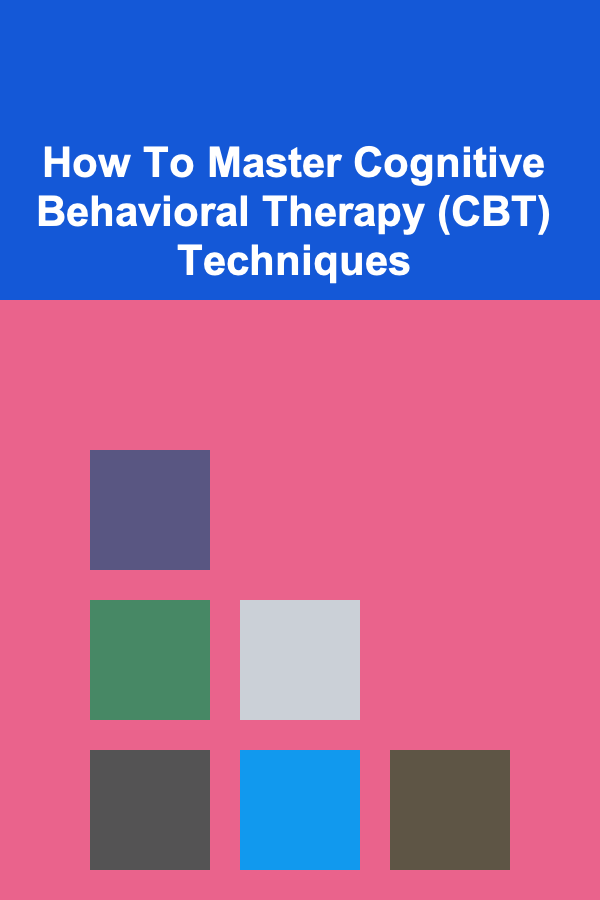
How To Master Cognitive Behavioral Therapy (CBT) Techniques
ebook include PDF & Audio bundle (Micro Guide)
$12.99$10.99
Limited Time Offer! Order within the next:

Cognitive Behavioral Therapy (CBT) has emerged as one of the most effective psychological treatments for various mental health conditions, including depression, anxiety, stress, and even certain behavioral issues. It is based on the idea that our thoughts, feelings, and behaviors are interconnected and that by changing the way we think, we can improve how we feel and act. Mastering CBT techniques can be a powerful tool for personal growth, emotional resilience, and managing mental health challenges. In this article, we will explore the essential aspects of mastering CBT techniques, the key principles behind them, and how to apply them to both therapeutic and everyday settings.
Understanding Cognitive Behavioral Therapy
Cognitive Behavioral Therapy is a structured, goal-oriented therapy that focuses on identifying and challenging unhelpful thought patterns and replacing them with healthier, more realistic alternatives. It is grounded in the understanding that how we think about situations influences how we feel and how we behave. The central tenet of CBT is that by changing negative or irrational thoughts, we can modify our emotional responses and behavior patterns.
CBT operates on the principle that our thoughts, emotions, and behaviors are interdependent. For instance, if someone constantly thinks that they are inadequate or worthless, these thoughts will often lead to feelings of sadness, frustration, or anxiety. These emotions can then trigger behaviors like withdrawal, procrastination, or self-sabotage. CBT seeks to break this cycle by helping individuals reframe negative thoughts, identify cognitive distortions, and adopt healthier thinking patterns.
Core Techniques of CBT
To master CBT techniques, it's crucial to understand the core techniques that make CBT effective. These techniques can be broadly classified into cognitive and behavioral interventions, each targeting a different aspect of the mind.
1. Cognitive Restructuring
Cognitive restructuring, also known as cognitive reframing, is one of the most important techniques in CBT. It involves identifying negative or distorted thought patterns and replacing them with more balanced, rational thoughts. The goal is to shift from "all-or-nothing" thinking to a more flexible, realistic perspective.
Steps for cognitive restructuring:
- Identify the Negative Thought: Start by identifying the negative thought or belief. This could be something like, "I'm going to fail at this," or "I am worthless."
- Examine the Evidence: Challenge the validity of the negative thought by examining the evidence. Are there past experiences that contradict this thought? Have you succeeded in similar situations before?
- Develop a Balanced Thought: Replace the negative thought with a more balanced one. For example, "I may face challenges, but I am capable of learning and improving."
- Evaluate the Outcome: Reflect on how the new, more balanced thought makes you feel. This shift in thinking often leads to an emotional improvement and a change in behavior.
By practicing cognitive restructuring, individuals can reduce the impact of negative thinking and increase their ability to cope with stressful situations.
2. Behavioral Activation
Behavioral activation is a technique primarily used to treat depression and low mood states. It involves engaging in activities that are aligned with one's values and interests to counteract the effects of depression. When people feel depressed, they often withdraw from pleasurable or meaningful activities, which exacerbates feelings of isolation and sadness. Behavioral activation seeks to break this cycle by encouraging individuals to take small, manageable steps toward positive activities.
Steps for behavioral activation:
- Identify Low-Energy Behaviors: Begin by identifying activities that are being avoided due to low mood. This could include socializing, exercising, or engaging in hobbies.
- Set Realistic Goals: Set small, achievable goals that will help reintroduce these activities into your routine. For instance, committing to a short walk every day or spending 10 minutes on a hobby.
- Monitor Progress: Track your progress and note any improvements in mood or energy levels. This reinforces the connection between positive behaviors and better emotional well-being.
- Reward Yourself: Reinforce the behavior by rewarding yourself after accomplishing each goal. This could be a simple act of self-praise or a tangible reward.
Behavioral activation helps individuals overcome inertia and engage in activities that contribute to their well-being, thus breaking the cycle of depression.
3. Thought Records
A thought record is a tool used to track and analyze the specific thoughts that lead to emotional distress. This technique involves writing down thoughts during moments of emotional discomfort and identifying patterns or cognitive distortions. Thought records help individuals gain insight into their thought processes and learn how to challenge unhelpful thinking.
Steps for using a thought record:
- Write Down the Situation: Record the event or situation that triggered emotional distress.
- Identify the Automatic Thought: Write down the automatic thought that immediately came to mind in response to the situation.
- Rate Your Emotional Reaction: Rate the intensity of the emotions you experienced (e.g., anxiety, sadness) on a scale of 1 to 10.
- Examine the Evidence: Look at the evidence for and against the automatic thought. Is there any evidence that contradicts the negative thought?
- Generate Alternative Thoughts: Come up with alternative, more balanced thoughts based on the evidence you've gathered.
- Rate Your Emotions Again: After considering the alternative thoughts, rate your emotions again. Has the intensity of your emotional response decreased?
Thought records are an excellent tool for increasing self-awareness and fostering the ability to challenge and reframe negative thoughts.
4. Exposure Therapy
Exposure therapy is a behavioral technique used to help individuals confront and reduce the anxiety associated with feared situations or objects. The idea is that avoidance of feared stimuli reinforces anxiety, while gradual exposure allows the person to become desensitized over time. This technique is particularly useful for treating phobias, post-traumatic stress disorder (PTSD), and generalized anxiety disorder.
Steps for exposure therapy:
- Identify Feared Situations: Start by identifying situations or objects that provoke anxiety or fear.
- Create an Exposure Hierarchy: Rank these feared situations from least to most anxiety-provoking. For example, if someone has a fear of public speaking, the hierarchy might start with speaking in front of a mirror and gradually progress to speaking in front of a large audience.
- Gradual Exposure: Begin with the least anxiety-provoking situation and gradually expose yourself to it. The goal is to stay in the situation long enough for the anxiety to decrease naturally.
- Increase Exposure Over Time: As you become more comfortable with one level of exposure, move on to more challenging situations on the hierarchy.
- Practice Relaxation Techniques: Use relaxation techniques, such as deep breathing, to manage anxiety during exposure.
Exposure therapy can help individuals overcome irrational fears by allowing them to experience the feared situations without the negative consequences they anticipate.
5. Mindfulness and Acceptance Techniques
Mindfulness and acceptance techniques are integral components of CBT that focus on increasing awareness of the present moment without judgment. These techniques help individuals become more aware of their thoughts, feelings, and bodily sensations, which fosters acceptance and reduces the tendency to engage in avoidance behaviors. Mindfulness practices, such as meditation, can help individuals detach from negative thoughts and emotions and observe them in a non-reactive way.
Steps for practicing mindfulness:
- Focus on the Present Moment: Pay attention to your current experience without judgment. This can involve focusing on your breath, bodily sensations, or the sounds around you.
- Notice Your Thoughts: Instead of trying to suppress negative thoughts, simply notice them as they arise. Label them as "thoughts" rather than facts.
- Practice Acceptance: Allow your thoughts and feelings to exist without trying to change them. This acceptance can reduce the emotional intensity of negative experiences.
- Return to the Present: If your mind begins to wander, gently guide your focus back to the present moment.
Mindfulness techniques promote emotional regulation and reduce the impact of negative thinking patterns.
Overcoming Obstacles in Mastering CBT Techniques
Mastering CBT techniques is not without its challenges. For many individuals, it can be difficult to change deeply ingrained thought patterns, especially if they have been reinforced over years or even decades. Here are some common obstacles and strategies to overcome them:
1. Resistance to Change
It's natural to feel resistance when trying to change long-standing habits or beliefs. The fear of discomfort or failure can often lead to avoidance of CBT practices. To overcome resistance, start with small, manageable goals. Break down complex tasks into smaller, more achievable steps. Remember that change is a gradual process, and self-compassion is key to maintaining motivation.
2. Lack of Awareness
Sometimes, individuals are unaware of their negative thought patterns or the impact they have on their emotions. Keeping a thought record or practicing mindfulness can help increase self-awareness and make it easier to recognize distorted thinking patterns. Regularly engaging in CBT exercises can improve your ability to notice when negative thoughts arise and take proactive steps to challenge them.
3. Inconsistent Practice
Consistency is essential for mastering CBT techniques. Practicing CBT regularly, even when things are going well, can help reinforce positive changes and prevent relapse. Setting aside time each day to engage in CBT exercises or keeping a journal of thoughts and behaviors can create a habit that becomes second nature over time.
4. Fear of Confronting Difficult Emotions
Some individuals may be hesitant to confront painful emotions, such as sadness, anger, or fear, as part of CBT. However, these emotions are often tied to unhelpful thought patterns that need to be addressed. One way to ease into this is by gradually confronting emotions in a safe, controlled way. Exposure therapy can also help individuals build tolerance to difficult emotions.
Conclusion
Mastering Cognitive Behavioral Therapy techniques is an empowering journey that can lead to lasting positive change in both mental health and everyday life. By practicing cognitive restructuring, behavioral activation, thought records, exposure therapy, and mindfulness, individuals can develop healthier thinking patterns, improve emotional resilience, and break free from self-destructive behaviors. While the path to mastery may involve challenges, the rewards of increased self-awareness, emotional regulation, and psychological well-being are well worth the effort. Whether you are a therapist, a student of psychology, or simply someone looking to improve your mental health, mastering CBT techniques can help you achieve greater emotional balance and a higher quality of life.

How to Create a Checklist for Website Security Maintenance
Read More
How to Handle Cancellations and Refund Requests in Event Registration
Read More
How to Make Your Small Space Feel Holiday-Ready
Read More
How to Explore Precision Diagnostics for Rare Diseases
Read More
Creating Winning Designs for POD Apparel (Hoodies & Sweatshirts)
Read More
How to Transition to a Digital Insect Care Checklist
Read MoreOther Products

How to Create a Checklist for Website Security Maintenance
Read More
How to Handle Cancellations and Refund Requests in Event Registration
Read More
How to Make Your Small Space Feel Holiday-Ready
Read More
How to Explore Precision Diagnostics for Rare Diseases
Read More
Creating Winning Designs for POD Apparel (Hoodies & Sweatshirts)
Read More